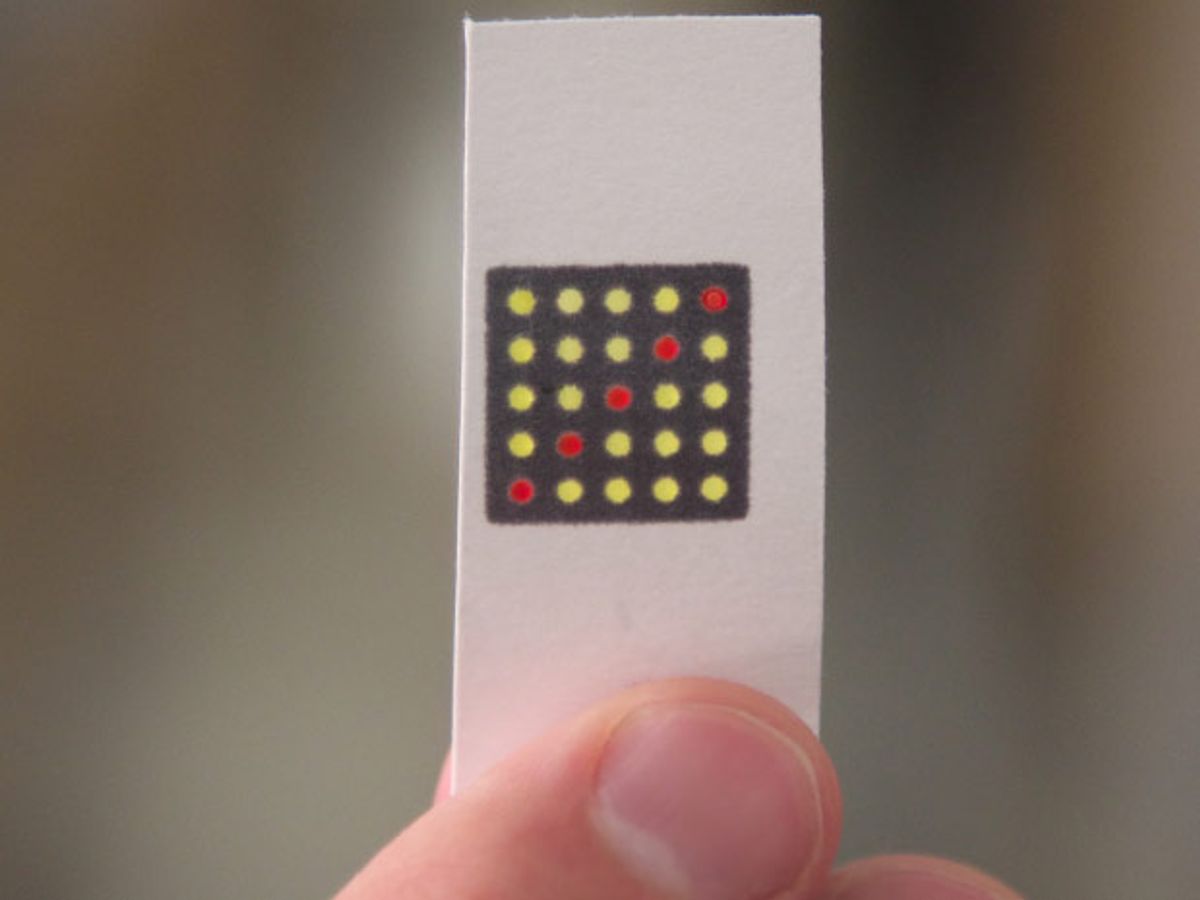In their new paper in the journal Cell, Keith Pardee, James J. Collins and colleagues from Collins’ lab at Harvard’s Wyss Institute for Biologically Inspired Engineering talk about networks, printing circuits, programming, and even orthogonality.
They’re not talking about electronics, though. They’re describing how they developed “paper-based synthetic gene networks” into a practical, and potentially revolutionary, diagnostic tool for detecting a wide range of biomolecular targets such as glucose and viruses.
It took them less than a day to produce a slip of paper that can detect the Ebola virus. Armed only with that slip and smartphone camera, a healthcare worker in the field could know within two hours—and sometimes in as little as 20 minutes—whether a patient is infected or not. And the doctor, nurse, or volunteer could do this without advanced skills, extensive sample preparation, expensive reagents, laboratory instruments, or even refrigeration.
“Our paper-based system could not only make tools currently only available in laboratory readily fieldable, but also improve the development of new tools and the accessibility of these molecular tools to educational programs for the next generation of practitioners,” wrote Collins.
To produce a synthetic gene network, selected chunks of DNA, RNA, proteins, organelles (including, importantly, the ribosomes that read messenger RNA, or mRNA, and translate it into proteins), and other biomolecules are freed from their cellular casings and isolated into a complete but non-living physiological pathway.
The Wyss researchers engineered their synthetic network, painted the stew onto paper (or cloth, or any other porous medium), and freeze-dried it into an inert dot. Add water and a bit of a triggering analyte—DNA from a suspicious virus, say—and the synthetic network goes to work, activating a cascade of reactions that causes the printed dot to change color. The approach could be used for detecting not just viruses, but a staggering variety of other targets.
A “toehold hairpin RNA” sensor is a key to the process. If a single strand of RNA includes complementary sequences at separated stretches along its length, it can fold back upon itself to form a hairpin. The Wyss researchers engineer an RNA sequence so that it includes: a stretch of detector RNA that will bind to messenger RNA produced by the target (a transcript Ebola virus produces to build coat proteins for new viruses, for example); a ribosome binding site sequence, which will prompt the ribosome to grab the molecule and start reading its instructions to make protein; a “closure” sequence that binds to the detector RNA, hiding the ribosome binding site in the loop of the hairpin; and mRNA instructions for an enzyme (such as beta-galactosidase) that will alter the structure of a reporter molecule (such as a yellow form of galactose) to change its color (say, to a purple). [See the video here.]
The design leaves the toehold, a short strip of detector RNA, dangling free at the bottom of the hairpin. The target RNA latches onto the toehold and starts zipping up along the rest of the detector sequence—and unzipping the closure sequence. This opens up the ribosome binding site in the hairpin. The unfolded mRNA then passes through the ribosome, and the ribosome produces the enzyme. The enzyme reacts with the reporter and, voila, the color changes.
The color changes can be seen with the naked eye or digitally quantified. Conventional laboratory plate readers will certainly do the job. But along the way, the Wyss team also developed algorithms that allow most digital color cameras, including those available in cellphones, to quantify color changes in the gene-network dots.
Pardee, Collins, and their colleagues report that paper-based synthetic gene networks offer a number of advantages, including cost, speed, and rapid development, over conventional diagnostic approaches.
Cost. Paper-based diagnostics could cost as little as US $0.02 to $0.04 per sensor, they say. This is dramatically lower than the $0.45 to $1.40 for familiar antibody-based rapid diagnostics tests (RDTs) like home pregnancy and glucose kits, and the $1.50 to $4.00 cost of the reagents used in a PCR (polymerase chain reaction) DNA assay.
Speed. The paper-based synthetic gene network diagnostics the Harvard team produced are about as fast as antibody-based home tests, a little faster than PCR, and much faster than the bacterial and viral culture methods that have been a diagnostic mainstay. The Wyss group’s paper diagnostics produce detectable color changes in 20 to 40 minutes (or perhaps longer, depending on the assay and the concentration of the target molecule). Antibody-based RDTs show results in about 20 minutes. And PCR assays require at least 60 minutes…and a well-equipped laboratory.
Rapid Development. As an exercise, the Wyss researchers gave themselves a day to develop an assay capable of detecting the Ebola virus, and of distinguishing between its Sudan and Zaire strains. They produced 24 Ebola sensors in less than 12 hours.
“Taken together,” the Wyss researchers conclude, “and considering the projected cost, reaction time, ease of use, and no requirement for laboratory infrastructure, we envision paper-based synthetic gene networks significantly expanding the role of synthetic biology in the clinic, global health, industry, research, and education.”
Images: Wyss Institute/Harvard University
Douglas McCormick is a freelance science writer and recovering entrepreneur. He has been chief editor of Nature Biotechnology, Pharmaceutical Technology, and Biotechniques.



